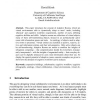Free Online Productivity Tools
i2Speak
i2Symbol
i2OCR
iTex2Img
iWeb2Print
iWeb2Shot
i2Type
iPdf2Split
iPdf2Merge
i2Bopomofo
i2Arabic
i2Style
i2Image
i2PDF
iLatex2Rtf
Sci2ools
COBUILD
1998
Springer
1998
Springer
Adaptive Rooms, Virtual Collaboration and Cognitive Workflow
This paper introduces the concept of Adaptive Rooms, which are virtual environments able to dynamically adapt to users' needs, including `physical' and cognitive workflow requirements, number of users, differing cognitive abilities and skills. Adaptive rooms are collections of virtual objects, many of them self-transforming objects, housed in an architecturally active room with information spaces and tools. An ontology of objects used in adaptive rooms is presented. Virtual entities are classified as passive, reactive, active, and information entities, and their sub-categories. Only active objects can be self-transforming. Adaptive Rooms are meant to combine the insights of ubiquitous computing -- that computerization should be everywhere, transparently incorporated -- with the insights of augmented reality -- that everyday objects can be digitally enhanced to carry more information about their use. To display the special potential of adaptive rooms, concrete examples are giv...
| Added | 05 Aug 2010 |
| Updated | 05 Aug 2010 |
| Type | Conference |
| Year | 1998 |
| Where | COBUILD |
| Authors | David Kirsh |
Comments (0)

